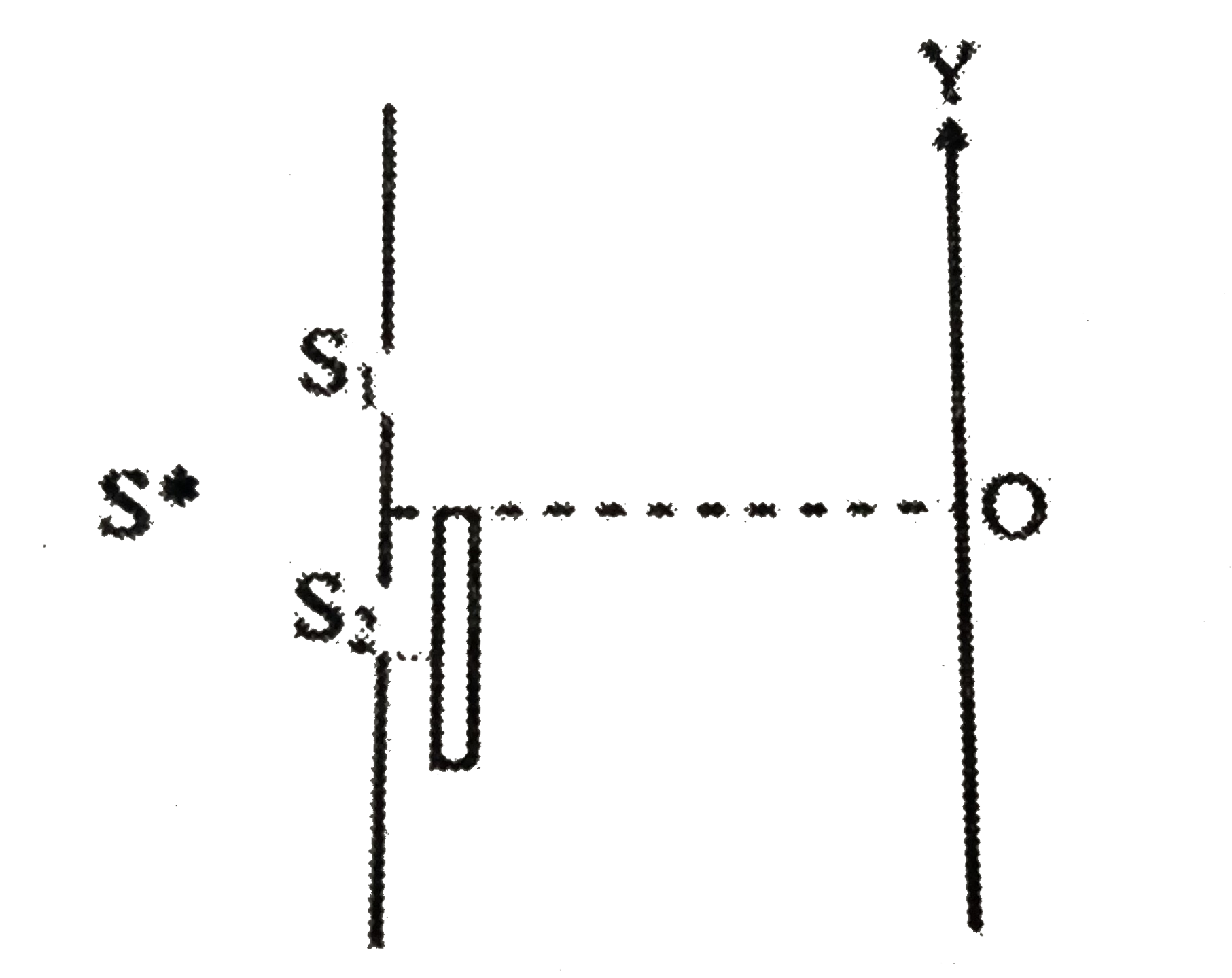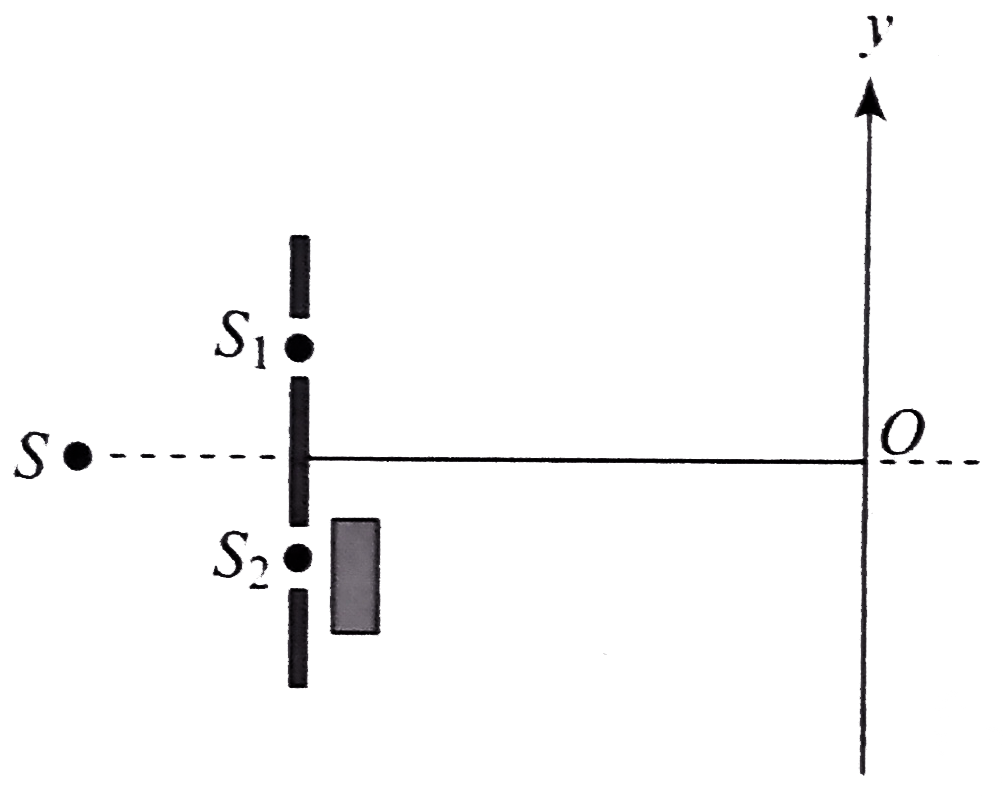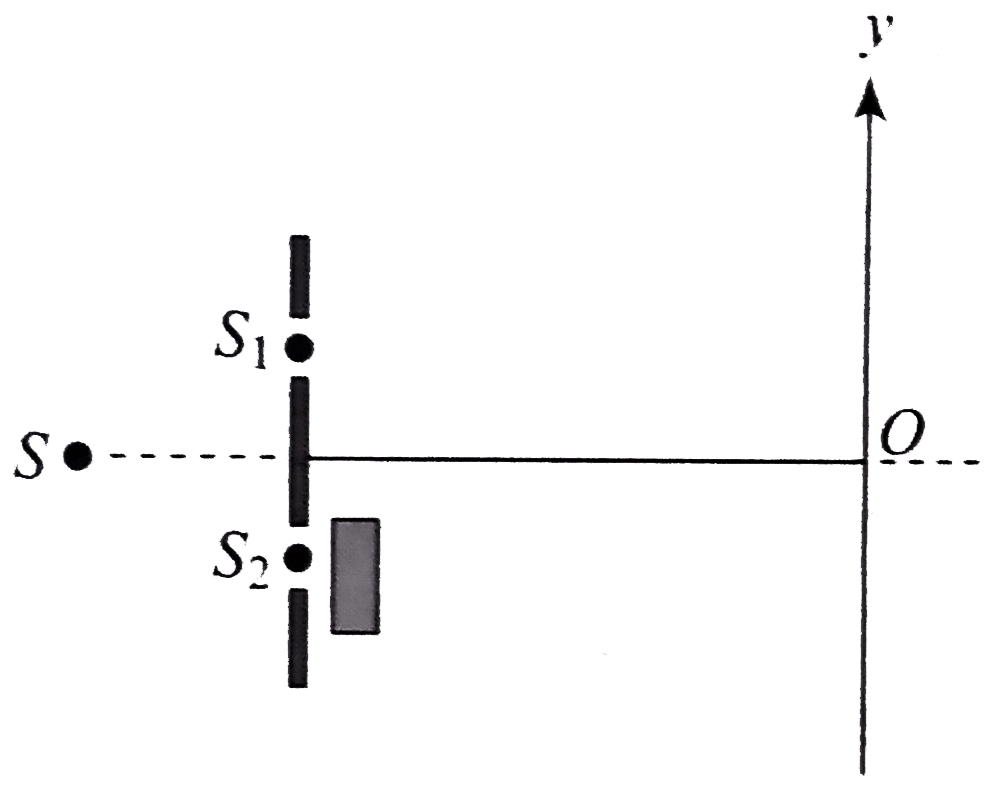The young's double slit experiment is done in a medium of refractive index 4/3.A light of 600nmwavelength is falling on the slits having 0.45 mm separation .The lower slit S2 is covered by a thin glass sheet of thickness 10.4μm and refractive index1.5.the intereference pattern is observed ona screen placed 1.5m from the slits are shown
![The young's double slit experiment is done in a medium of refractive index 4//3.A light of 600nmwavelength is falling on the slits having 0.45 mm separation .The lower slit S(2) is covered by a thin glass sheet of thickness 10.4mu m and refractive index1.5.the intereference pattern is observed ona screen placed 1.5m from the slits are shown (a) Find the location of the central maximum (bright fringe with zero path difference)on the y-axis. (b) Find the light intensity at point Orelative to the maximum fringe intensity. (c )Now,if 600nmlight is replaced by white light of range 400 to700 nm find the wavelength of the light that from maxima exactly point O.[All wavelengths in this problem are for the given medium of refractive index 4//3 .Ignore dispersion]](https://d10lpgp6xz60nq.cloudfront.net/physics_images/NG_PHY_WO_C02_E01_008_Q01.png)
(a) Find the location of the central maximum (bright fringe with zero path difference)on the y-axis.
(b) Find the light intensity at point Orelative to the maximum fringe intensity.
(c )Now,if 600nmlight is replaced by white light of range 400 to700 nm find the wavelength of the light that from maxima exactly point O.[All wavelengths in this problem are for the given medium of refractive index 4/3 .Ignore dispersion]
The correct Answer is:A, B, C, D

(a) Let the central maxima is obtained at a distance x below O.[This is because a glass sheet is present is front of S2which∈creasesitspath≤n>h→thescreen.Thereforethepath≤n>hofrayomS_(1)→thescreenshod––also∈crease].<br>Here,<br>implies(xs)/(D)=((mu_g)/(mu_m)-1)t<br>impliesx=((mu_g)/(mu__m)-1)txx(D)/(d)=((1.5)/((4)/(3))-1)xx((10.4xx10^(-6))(1.5))/(0.45xx10xx^(-3))<br>=4.33xx10^(-3)m<br>(b)ForO,pathd⇔erence=((mu_g)/mu_m-1)t<br>:'Phased⇔erencephi=(2pi)/(lamda)((mu_g)/(mu_m)-1)t=(2xx3.14)/(6xx10^(-7))((1.5)/((4)/(3))-1)(10.4xx10^(-6))=6.8rad<br>WeknowtˆI=I_(0)cos^(2)(phi)/(2):'(I)/(I_(0))=cos^(2)(6.8)=0.75<br>(c)Formaxima,pathd⇔erence+=nlamda<br>:'nλ=(μgμm−1)t
⇒λ=(μgμm−1)tn=⎛⎝1.543−1⎞⎠10.4×10−6n
=1.3×10−6n
Putting different values of n for find the wave length in the range of 0.4×10−6m to 0.7×10−6m we get λ=0.65×10−6m and 0.433x10−6m
Topper's Solved these Questions
Similar Questions
Young’s double slit experiment is done in a medium of refractive index 4/3. Light of 600 nm wavelength is falling on the slits having 0.45 pm separation. The lower slit S2 is covered by a thin glass sheet of thickness 10.4 pm and refractive index 1.5. The interference pattern is observed on a screen placed 1.5 m from the slits as shown.
(a) Find the location of central maxima (bright fringe with zero I t y path difference) on the y-axis.
(b) Find the light intensity at point O relative to the maximum fringe intensity.
(c) Now, if 600 nm light is replaced by white light of range 400 to 700 nm, find the wavelengths of the light that from maxima exactly at point O[All wavelengths in this problem are for the given medium of refractive index 43. Ignore dispersions.]
 View Solution
View SolutionA monochromatic beam of bright of light of wavelength 5000Å is used in Young's double slit experiment. If one of the slits is covered by a transparent sheet of thikness 1.4×10−5m, having refractive index of its medium 1.25. Then the number of fringes shifted is
View Solution
Knowledge Check
- Question 1 - Select One
The young's slit experiment is done in a medium of refractive index 4/3 .A light of 600 nm wavelength is falling on the slits having 0.45 mm separation . The lower slit S2 is covered by a thin galss sheet of thickness 10.4 μm and r3efractive index 1.5 .The interferecnce pattern is observed on a screen placed 1.5 m form the slits as shown in figure .Find the light intensity at point O relative to the maximum fringle intensity
(Given:cos3.4=√0.75
 A14B12C34D0
A14B12C34D0 - Question 2 - Select One
A YDSE is performed in a medium of refractive index 4/3, A light of 600 nm wavelength is falling on the slits having 0.45 nm separation . The lower slit S2 is covered b a thin glass plate of thickness 10.4 mm and refractive index 1.5. The interference pattern is observed on a screen placed 1.5 m from the slits as shown in figure. (All the wavelengths in this problem are for the given medium of refractive index 4/3, ignore absorption.)

Find the light intensity at point O relative t maximum fringe intensity.A14ImaxB54ImaxC12ImaxD34Imax - Question 3 - Select One
In YDSE's experiment performed in a medium of refractive index (4/3), a light of 60 nm wavelength is falling ono the slits having 0.45 mm separation.t he lower slit S2 is covered by a thin glass sheet of thickness 10.4μm and refractive index 1.5 the interference pattern is observed on a screen palced 1.5m from the slits as shown int hef ignore dispersion.
Q. If white light of range 400-700 nm has replaced 600 nm light, one of the wavelengths of light that forms maxima exactly at point O wll be:
 A650 nmB625 nmC550 nmD605 nm
A650 nmB625 nmC550 nmD605 nm
A YDSE is performed in a medium of refractive index 4/3, A light of 600 nm wavelength is falling on the slits having 0.45 nm separation . The lower slit S2 is covered b a thin glass plate of thickness 10.4 mm and refractive index 1.5. The interference pattern is observed on a screen placed 1.5 m from the slits as shown in figure. (All the wavelengths in this problem are for the given medium of refractive index 4/3, ignore absorption.)

The location of the central maximum (bright fringe with zero path difference) on the y-axis will beView SolutionA YDSE is performed in a medium of refractive index 4/3, A light of 600 nm wavelength is falling on the slits having 0.45 nm separation . The lower slit S2 is covered b a thin glass plate of thickness 10.4 mm and refractive index 1.5. The interference pattern is observed on a screen placed 1.5 m from the slits as shown in figure. (All the wavelengths in this problem are for the given medium of refractive index 4/3, ignore absorption.)

Now, if 600 nm, find the wavelength of the ligth that forms maximum exactly at point O.View SolutionMonichromatic lightof wavelenght 600 nm is used ina Young's double slilt experient. One of the slits is covered by a transparent sheet of thicknes 1.8×10−5 m made of a material of refractive index 1.6. How many fringe will shift due to the introduction of the sheet?
View SolutionMonichromatic lightof wavelenght 600 nm is used ina Young's double slilt experient. One of the slits is covered by a transparent sheet of thicknes 1.8×10−5 m made of a material of refractive index 1.6. How many fringe will shift due to the introduction of the sheet?
View SolutionIn Young's double-slit experiment, if both the slits are covered by a thin transparent sheet of thickness t and refractive index n, the optical path difference between the two interfering waves
View Solution

